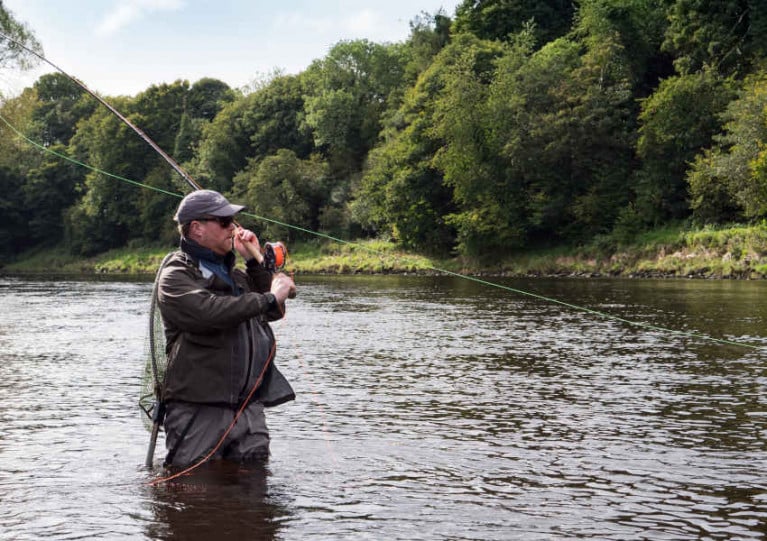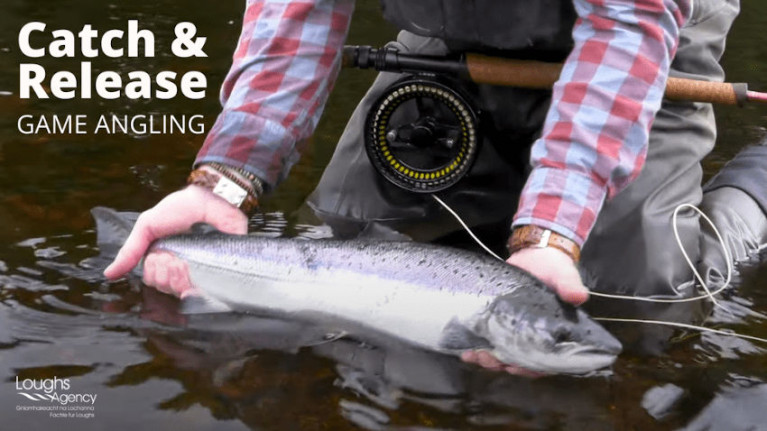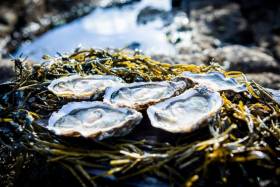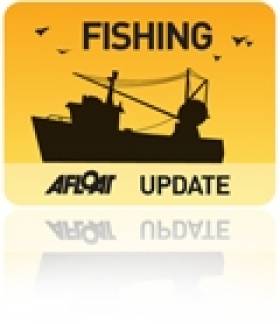Displaying items by tag: Carlingford
While some anglers enjoyed success on the rivers within Foyle and Carlingford in 2020, the Loughs Agency says it continues to take a precautionary approach in line with national and international trends.
The State of the Salmon Report published by the international lead on salmon management, the North Atlantic Salmon Conservation Organization (NASCO), highlights the worrying and continuous decline in the populations of the Atlantic salmon.
NASCO states: “It now takes about double the amount of eggs to produce one adult (compared to 1990s) that will return to that same river to spawn — an indication of the multiple pressures facing the species throughout its complex life cycle.”
This decline continues to be reflected locally, the Loughs Agency warns, with rivers such as the Finn in Co Donegal failing to reach their conservation targets in 2020 and therefore will continue to operate on a catch and release basis for the 2021 season.
Now the agency is calling on anglers to take steps to ensure sustainability of the fisheries of Foyle and Carlingford. Anglers are encouraged to:
- Update their catch return and fishing effort regularly throughout the season on the eLicence website. This data is used to help Loughs Agency manage the fishery using real-time data.
- Keep the Loughs Agency’s 24hr Response Line telephone number +(0) 44 2871 342100 as a contact on their phone and report any concerns directly and promptly. The Loughs Agency relies on reports of illegal fishing and pollution from the public.
- Practice catch and release. Many anglers already do this, with around 45% of anglers not taking carcass tags when they purchase their licence.
- Implement biosecurity measures to prevent the spread of invasive species.
- For the 2021 season, the Loughs Agency is issuing a maximum of one blue tag for the period 1 March to 31 May and/or a maximum two black tags for the period 1 June to 31 October, depending on the type of licence purchased. Tackle shops have been instructed not to issue more than these maximum quantities for the 2021 season.
The rivers Film and Foyle opened this past Monday 1 March, signalling the start of the salmon, sea trout and wild brown trout angling season. However, game, coarse and sea angling is already available in both catchments.
For still water game anglers, Binevenagh Lake opened on 1 February. The lake lies on a basalt plateau that towers over Lough Foyle and its flanking lowlands below with the famed hills of Donegal beyond.
The 3.2 hectare lake is regularly stocked with rainbow trout by DAERA Inland Fisheries and successful flies include Bibio and Buzzer patterns.
Fly fishing, spinning and worm fishing are permitted and the fishery has a daily bag limit of four trout per rod. A Loughs Agency game rod licence and a DAERA game angling permit are required to fish this water.
Some private fisheries are also operating and offer fishing for rainbow trout including Ballyheather, Altmore, Birchwood, Cashel, Termon, Oaks, Glenowen, and Duncrun Fishery in the Foyle area. In the Carlingford area, Donaghaguy Reservoir is open for trout fishing. A Loughs Agency game licence and a permit from the relevant fishery are required to fish these waters.
 Coarse angling on the Newry Canal | Photo: Loughs Agency
Coarse angling on the Newry Canal | Photo: Loughs Agency
Coarse angling is permitted all year round, but the climate impacts on which species can be targeted. While tench, bream and rudd are active in warmer weather, roach and perch feed in all seasons and make good year round fishing for the coarse angler.
In the Foyle area, coarse fishing is currently available at Aghlisk Lough, Baronscourt Lakes, Enagh Lough, Longvale and Lough Muck near Omagh. In Carlingford, anglers can also fish for roach and perch at Bessbrook, Camlough, Derryleckagh, Drumlough, Greenan Lough, Mill Dam, Milltown Lough and in Newry Canal. A Loughs Agency coarse licence and permission from the relevant fishery owner is required to fish these lakes. In some cases a day ticket must be purchased.
The marine waters in Foyle and Carlingford offer fantastic sea angling with stunning landscapes and seascape backdrops. Flounder, bass, dogfish, dab, rockling, conger, pollock and ray are likely catches for the shore angler.
The Foyle area has over 90 miles of coastline of inlets, beaches, estuaries and rocky shores from which to cast from, while Carlingford offers almost 30 miles of coastline opportunities to fish. No licence is required for sea angling, but if fishing for salmon or sea trout a Loughs Agency game licence is required for the season.
Anglers are reminded to comply with the latest government advice and restrictions to stop the spread of COVID-19. For further information on season dates, licence and permit requirements in the Foyle and Carlingford areas, visit the Loughs Agency website’s angling section HERE.
Loughs Agency Renews Appeal for Anglers to ‘Catch & Release’
The Loughs Agency has launched a new campaign appealing for angling enthusiasts to embrace the practice of catch and release to help sustain fish stocks in the Foyle and Carlingford areas.
The agency says it welcomes the growing trend of catch and release angling as a way of continuing to fish while limiting the impact on local stocks.
And it has produced a video guide to help anglers with their catch and release technique in order to increase the survival rate of salmon after release.
John McCartney, the agency’s director of conservation and protection, also explains the carcass tagging scheme which applies to salmon, brown trout and sea trout retained by recreational anglers, and highlighted the importance of returning any unused tags.
The Loughs Agency is aiming for a catch and release rate of over 80% for salmon and sea trout caught during the new season which is now partially underway.
It also wants to further reduce the number of anglers opting to take tags when purchasing a licence.
‘The agency welcomes this approach to angling and would encourage all anglers to practice this method’
McCartney says: “Last year, 45% of anglers purchasing a licence opted not to take tags and there is a growing trend of anglers implementing the practice of catch and release.
“The agency welcomes this approach to angling and would encourage all anglers to practice this method as a way of continuing to fish, whilst limiting the impact on local stocks.
“Numbered tags are allocated to anglers who request them when they purchase their licence. The angler then records their retained catch and the corresponding carcass tag number when updating their catch return during the fishing season, returning any unused tags to Loughs Agency when their licence expires.
“The catch return data from anglers is analysed throughout the season and used to make fishery management decisions to ensure the sustainability of species in Foyle and Carlingford.”
For the 2021 season, the Loughs Agency is issuing a maximum of one blue tag for the period from 1 March to 31 May and/or a maximum of two black tags for the period from 1 June to 31 October, depending on the type of licence purchased. Tackle shops have been instructed not to issue more than these maximum quantities for the 2021 season.
The above video guide to good practice for anglers with their catch and release technique includes the following pointers:
- Landing the fish quickly to avoid exhausting the fish.
- Use a soft knotless mesh net and keep the fish in the water at all times.
- If you must handle the fish, use wet hands and cradle it below the belly. Never put your fingers inside the gill covers or lift the fish by the tail.
- Use a single barbless hook to limit injury during removal. Remove the hook immediately, keeping the fish in the water.
- If the hook is caught deep in the fish, cut the line and release with hook still inside rather than trying to remove deep-caught hook.
- When releasing the fish, support it in the water using two hands, with the head pointing upstream to aid breathing.
The season has already started on some still-water fisheries, with fishing on the rivers beginning to open up from Monday 1 March.
For further information on season dates, licence and permit requirements in the Foyle and Carlingford areas, visit the angling section of the Loughs Agency website.
Foyle & Carlingford Anglers Urged to Make 2020 Catch Returns to Support Scientific Research
The Loughs Agency is reminding anglers in the Foyle and Carlingford areas to log and submit their angling effort, catches and releases for the 2020 season.
Rod licences for salmon and sea trout in Foyle and Carlingford come with a legal obligation to inform the Loughs Agency (via the eLicence web portal) of how many times the licence holder went fishing and got many fish they caught.
To date, the agency says less fewer than 10% of anglers have made their return for the 2020 season.
For the 2020 season, the Loughs Agency will be carrying out an in-depth study of catch returns and angling effort to determine fish runs in rivers, number of fish caught, weight of fish caught and/or released, and how much time anglers put into catching those fish.
As a result, anglers are encouraged to make their return and be as accurate as possible with locations, dates, weights, species, methods and time spent fishing.
The deadline for catch returns is Thursday 21 January 2021.
Permits Now Available For Loughs Agency Fisheries
As of yesterday (Tuesday 19 May), permits are available for Loughs Agency permit waters on the River Foyle, River Finn (approx six miles) and Greenbraes Fishery.
DAERA has also opened, with limitations, the Public Angling Estate in Northern Ireland — which in the Foyle and Carlingford areas includes Loughbrickland, Binevenagh, Moor Lough, Lough Ash, Lough Bradan, Lough Lee and a section of the River Roe.
The Loughs Agency adds that angling clubs and private fisheries will decide how and when to open their waters.
It is for each club and fishery owner to decide if they can comply with government advice with regard to social distancing and hand hygiene.
Anglers are reminded that they also have individual responsibility to comply with UK and Irish government advice regarding social distancing, hand hygiene and travel restrictions.
The agency’s fisheries protection staff have returned to full-time duties with immediate effect and will continue to work in partnership with the PSNI and An Garda Síochána with regard to fisheries offences.
Game and coarse anglers are also reminded that to fish in the waters of Foyle and Carlingford they require a licence from Loughs Agency and a permit from whomever holds the fishing rights.
Loughs Agency licences are available online. Anglers should contact the fishery/angling club directly regarding permits that are not provided by Loughs Agency.
Foyle & Carlingford Anglers Encouraged To Make Catch Returns For 2019
Anglers are being encouraged by the Loughs Agency to log and submit their efforts, catches and releases for the 2019 angling season in Foyle and Carlingford.
Whenever anyone buys a rod licence to fish for salmon and sea trout in Foyle and Carlingford, they are legally obliged to let the Loughs Agency know if they have caught fish and how many times they went fishing.
This information can now be easily recorded through the loughs angling elicence website. Simply log in with your Angler Number and update your angling log for the 2019 season.
John McCartney, Lough Agency director of conservation and protection, said: “This is really important information because it enables our scientists to understand how many fish are caught, taken or returned back to the river and how much time anglers put into catching those fish.
“It provides an indication of how well stocks are doing and if we need to take any action should catches take a turn for the worst.”
Freshwater fishery biologist Mark McCauley advised that the data is used “to screen proposed developments such as roads, hydro, etc that may impact the interests of the fishery. We can also use the data anglers provide to assess the strength of fish runs in the system this year and also for long term trend monitoring.”
As reported last week on Afloat.ie, salmon and sea trout anglers in the Republic of Ireland have been reminded to return their 2019 logbooks and unused gill tags as soon as possible, even if there is no catch recorded.
New Carlingford Service Facing Possible Delay
#Delays - The Scenic Carlingford Ferry, which was set to launch this month has stated that it is "looking like it could be another couple of weeks" before the car-ferry is ready to get underway.
In the Dundalk Gazette, the Chief Executive of the ferry operator Pamela Houston said, “We are still hoping to set sail officially in June but it is looking like it could be another couple of weeks. We are quite simply at the mercy of bespoke navigational aids and once they are delivered and installed, we can get underway.”
“We are, as you would expect, following due process in terms of the official sequence for final approvals before opening the service for passengers. All the Captains are hugely experienced and already carry the official Certificate of Competency to operate a range of vessels, hence they can be seen putting the Ferry through its paces.”
For more on the story click here.
Carlingford To Host European Championships For Global Swim Series
#Swimming - Carlingford in Co Louth is the venue for the Global Swim Series European Championships on Saturday 15 October.
Ireland has already hosted 14 races in the international league for open water swimming, which included the legendary Liffey Swim and more recently the Dun Laoghaire Harbour Race.
So it should come as no surprise that Irish swimmers — and in particular swimmers from Northern Ireland — are topping the series leaderboards heading into Carlingford Lough’s first hosting of the European Championships in less than two weeks’ time.
The event also marks the point where racing moves to the Southern Hemisphere and swimmers in Australia, New Zealand, Brazil, the Philippines and the Pacific islands set their sights on the top of the table before the series concludes next April.
Carlingford Oyster Festival Opens Today
#MaritimeFestivals - The 2016 Carlingford Oyster Festival kicks off this evening (Thursday 4 August) on the shores of Carlingford Lough with the official opening of the event that runs till Monday 8 August.
This Saturday (6 August) is when the festivities really under way, with local restaurants offering samples of their finest seafood dishes.
Visitors will have an opportunity to try some of the Co Louth town's renowned local oysters at the Festival Oyster Tent.
There will also be guided tours of what's one of Ireland's few remaining Medieval walled towns, to coincide with Irish Walled Towns Day on Sunday 7 August.
Coastguard Helicopter In Trawler Medevac Off Carlingford
#Coastguard - Dublin's Irish Coast Guard helicopter was involved in a rescue off the north-east of Ireland early this morning (Tuesday 16 February), as Independent.ie reports.
Rescue 116 assisted Belfast Coastguard in the medevac of a fisherman who suffered head injuries on a trawler 25 miles off Carlingford, Co Louth.
The man was airlifted to Daisy Hill Hospital in Newry where his condition is not yet confirmed.
Fishing Vessel Skipper Charged Over Carlingford Lough Collision
#collisio – At a hearing today in the County Court Division of South Down, Lindsay Haugh, the Skipper of the fishing vessel Onward N336, was fined a total of £2,500 plus costs of £231 after pleading guilty for failing to keep a proper lookout, according to the UK's Maritime and Coastguard agency.
On 12th September 2014 at approximately midnight the fishing vessel Onward N336 was heading back from fishing grounds in thick fog to its home port of Killkeel when it collided with the Clipper Pennant, a Seatruck Ferries vessel at anchor off Carlingford Lough, Northern Ireland.
Lindsay Haugh, aged 44, from Killkeel pleaded guilty to unlawful conduct endangering ships, structures or individuals off Carlingford Lough, contrary to section 58 of the Merchant Shipping Act 1995, in that he omitted to monitor the recognised VHF channels, omitted to view radar in reduced visibility and omitted to keep a proper look out and as such omissions were deliberate or amounted to a breach, or neglect of duty.
In passing sentence His Worship District Judge King said, "Haugh fully accepted his responsibility and pleaded guilty at the first opportunity.
"Sea collisions are a serious responsibility. You as captain at sea are responsible for the boat, the crew and other persons at sea.
This is a serious matter and thankfully there was no serious damage or loss of life."
David Carlisle, Consultant Surveyor at the Maritime & Coastguard Agency (MCA) said: "This was a serious avoidable incident. Mr Haugh did not keep an effective watch in what was serious reduced visibility, nor did he observe the warning signals sounded from the Clipper Pennant."





































































